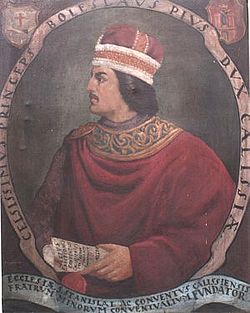Bolesław the Pious
| Bolesław the Pious | |
|---|---|

Bolesław the Pious
|
|
| Spouse(s) | Jolenta of Poland |
| Noble family | House of Piast |
| Father | Władysław Odonic |
| Mother | Hedwig |
| Born | between 1224 and 1227 |
| Died | 14 April 1279 Kalisz |
| Buried | Archcathedral Basilica of St. Peter and St. Paul, Poznań |
Bolesław the Pious (Polish: Bolesław Pobożny) (1224/27 – 14 April 1279) was a Duke of Greater Poland during 1239–1247 (according to some historians during 1239–1241 sole Duke of Ujście), Duke of Kalisz during 1247–1249, Duke of Gniezno during 1249–1250, Duke of Gniezno-Kalisz during 1253–1257, Duke of whole Greater Poland and Poznań during 1257–1273, in 1261 ruler over Ląd, regent of the Duchies of Mazovia, Płock and Czersk during 1262–1264, ruler over Bydgoszcz during 1268–1273, Duke of Inowrocław during 1271–1273, and Duke of Gniezno-Kalisz from 1273 until his death.
He was the second son of Władysław Odonic, Duke of Greater Poland by his wife Hedwig, who was probably the daughter of Mestwin I, Duke of Pomerania, or a member of the Přemyslid dynasty. His name was very popular in the Piast dynasty, so it's unknown exactly after whom he was named. Very soon Bolesław received the nickname of "the Pious" (Latin: Pius), given to him during his lifetime by the Chronicle of the Chapter of Poznań.
The first years of Bolesław saw him share the fierce dispute of his father against Władysław III Spindleshanks (his own uncle) for his inheritance. However, Władysław Odonic took care properly for the upbringing of his offspring, evidenced by the fact that Bolesław, like his older brother Przemysł I, was able to read and write Latin.
...
Wikipedia
